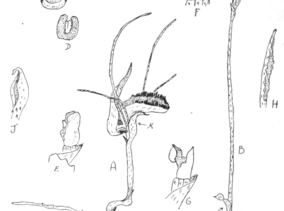You are here
Acianthinae_species
Corybas cryptanthus Hatch
Nomenclature
-
Genus: CorybasSubgenus: Corysanthes
-
Synonyms: 3
Media
SUMMARY
Plant: perennial, saprophytic, almost subterranean
Tuber: none
Rhizome: horizontal, creeping on along soil surface, slender (1 mm), whitish, branching from the axils of the cataphylls, the internodes sparsely scattered with short rootlets, tuberous nodules along its length
Leaf: solitary, terminal, whitish with red flecks, oblong-acute or -apiculate, up to 1 cm. long by 4 mm. broad
Bract: rudimentary, minute, secondary bract wanting
Flower: solitary, sessile on the leaf, translucent with red flecks and fimbriae, up to 25 mm. high, and completely buried under the surface debris
Dorsal sepal: erect, concave, acuminate
Lateral sepals: filiform-caudate, erect or spreading.
Lateral petals: similar, about a third as long
Labellum: tubular at the base, disc expanded, orbicular, the margins more or less upturned, with irregular red fimbriae.
Auricles: prominent, open.
Column: as in C. rivularis, but differing in the prominent column-wings being continued behind and above the anther.
Capsule: on peduncle elongating up to 15 cm high, with conspicuous bright red flecks.
Type: in Herb. Hatch, No. 569 Wellsford, 29. July 1950, E. D. Hatch. The accompanying illustration can be regarded as the hypotype of the species.
Distribution: Endemic to New Zealand; The only reference to its having been seen south of Reefton and North Canterbury is an isolated report from Manapouri. Dome Valley north of Warkworth by Bruce Irwin and Owen Gibson in October 1949.
Ecology: Whole plant, except for mature capsule, typically buried beneath the debris of twigs, leaves, leaf litter (beech or manuka) and moss on forest floor. Self-pollinating.
Distribution






































